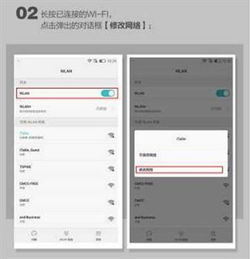
大小:
下载:172次
分类:手机软件
手机wifi速率怎么设置
手机wifi速率144 手机wifi速率最高多少 手机wifi速率150mbps 手机wifi速率怎么看 手机wifi速率对照表
- 支 持:
- 大 小:
- 开发者:
- 提 现:
- 说 明:
- 分 类:手机软件
- 下载量:172次
- 发 布:2024-05-03
手机扫码免费下载
纠错留言#手机wifi速率怎么设置简介
Title: Maximizing Mobile WiFi Speeds: Tips and Strategies
In the fastpaced world of mobile connectivity, optimizing WiFi speeds on your smartphone is crucial for seamless browsing, streaming, and downloading. Several factors can influence WiFi performance, from your device's capabilities to environmental conditions and network settings. Let's delve into strategies to maximize your mobile WiFi speeds:
1. Choose the Right WiFi Network:
Frequency Bands:
WiFi networks operate on two primary frequency bands, 2.4 GHz and 5 GHz. While 2.4 GHz offers better range, 5 GHz provides faster speeds with less interference. Whenever possible, connect to a 5 GHz network for enhanced performance.
Network Strength:
Opt for networks with strong signals. Weak signals lead to slower speeds and intermittent connections. Position yourself closer to the router or access point for better signal strength.2. Update Device and Router Firmware:
Regularly update your smartphone's firmware and router firmware to ensure compatibility with the latest WiFi standards and security protocols. Manufacturers often release updates to address performance issues and vulnerabilities.
3. Optimize Router Placement:
Position your router in a central location within your home or workplace to minimize signal interference and maximize coverage. Avoid placing the router near thick walls, large appliances, or other electronic devices that can obstruct signals.
4. Reduce WiFi Interference:

Channel Selection:
Use WiFi analyzer apps to identify less congested WiFi channels and switch to them for improved performance. This helps mitigate interference from neighboring networks.
Interference Sources:
Keep electronic devices such as microwaves, cordless phones, and Bluetooth devices away from the router, as they can disrupt WiFi signals.5. Enable WiFi Security:
Protect your WiFi network with strong encryption (WPA2 or WPA3) and a unique password to prevent unauthorized access. Open networks are more susceptible to bandwidth theft and security breaches, leading to degraded performance.
6. Manage Background Applications:
Close or disable background apps consuming excessive data or bandwidth. Apps running in the background can hog network resources, slowing down your WiFi speeds. Monitor data usage and restrict background activity where necessary.
7. Use QualityofService (QoS) Settings:
Some routers offer QoS settings that prioritize certain types of traffic, such as video streaming or online gaming, for a smoother experience. Customize QoS settings based on your usage patterns to allocate bandwidth efficiently.
8. Invest in WiFi Extenders or Mesh Systems:
For larger homes or offices with WiFi dead zones, consider deploying WiFi extenders or mesh WiFi systems to enhance coverage and maintain consistent speeds throughout the premises.
9. Perform Regular Speed Tests:
Use speed test apps or websites to periodically assess your WiFi speeds. This helps identify performance bottlenecks and troubleshoot connectivity issues promptly.
10. Consider Network Upgrades:
If you consistently experience slow WiFi speeds despite optimization efforts, consider upgrading your Internet plan or investing in a faster router compatible with the latest WiFi standards, such as WiFi 6 (802.11ax).
By implementing these strategies and staying proactive about optimizing your mobile WiFi experience, you can enjoy faster speeds, smoother connectivity, and a more satisfying online experience on your smartphone.








